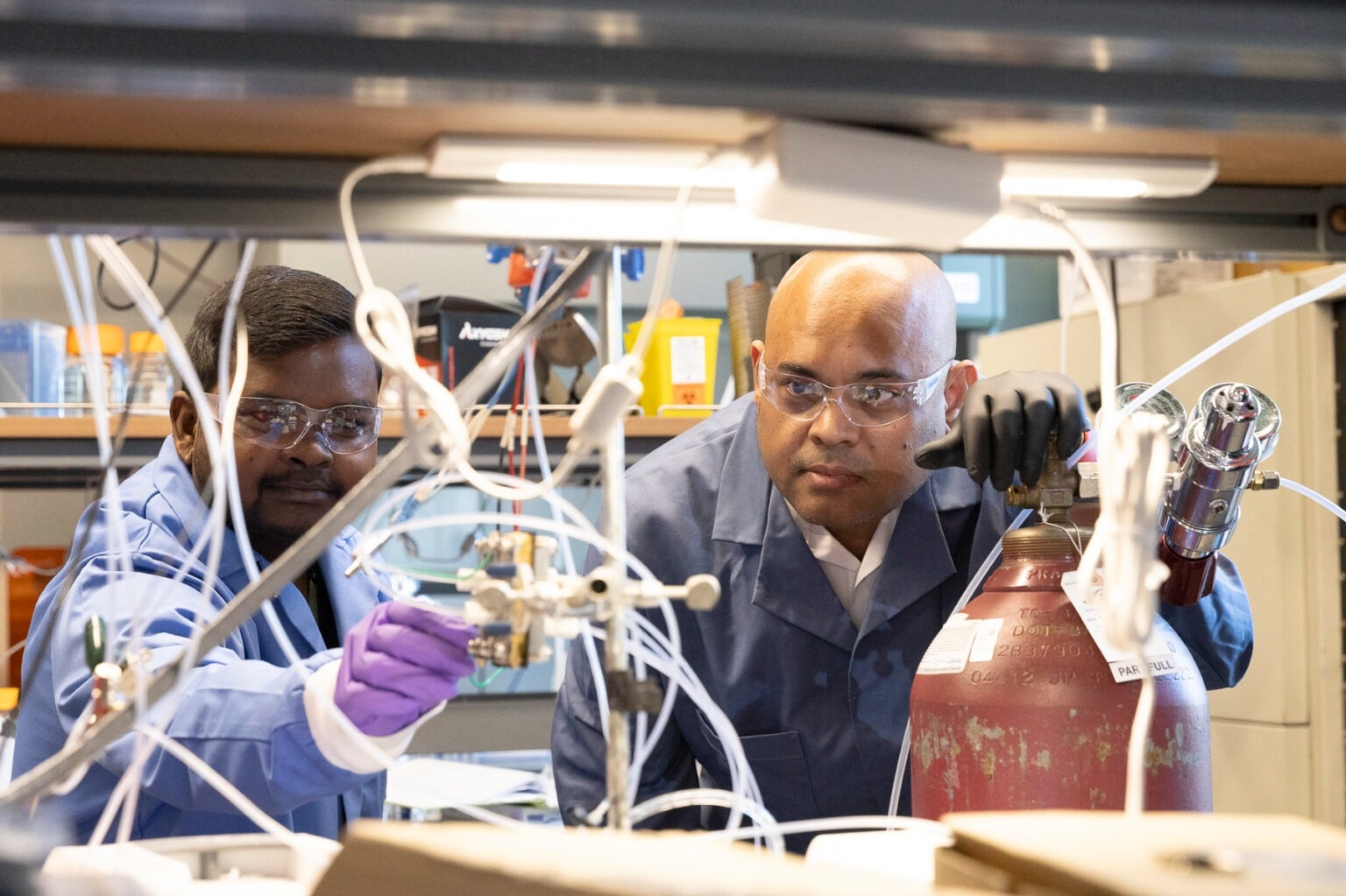Reviewed by Lexie CornerMay 31 2024
A multi-institutional team led by engineer Meenesh Singh of the University of Illinois Chicago developed a novel technique for producing hydrogen gas from water using solar power and agricultural waste, such as manure or husks. These findings were published in Cell Reports Physical Science.
 Associate Professor Meenesh Singh and postdoctoral researcher Rohit Chauhan work in Singh’s laboratory at the University of Illinois Chicago. Image Credit: Jenny Fontaine/ UIC
Associate Professor Meenesh Singh and postdoctoral researcher Rohit Chauhan work in Singh’s laboratory at the University of Illinois Chicago. Image Credit: Jenny Fontaine/ UIC
The technique reduces the energy required to extract hydrogen from water by 600 %, opening up new possibilities for the creation of environmentally friendly, sustainable chemicals.
Hydrogen-based fuels are among the most promising sources of sustainable energy. However, creating pure hydrogen gas is an energy-intensive process that frequently necessitates coal, natural gas, and considerable amounts of electricity.
The approach employs biochar, a carbon-rich material, to reduce the amount of electricity required to convert water to hydrogen. The technique can reduce greenhouse gas emissions to zero by utilizing renewable energy sources such as solar or wind power and collecting byproducts for other purposes.
We are the first group to show that you can produce hydrogen utilizing biomass at a fraction of a volt. This is a transformative technology.
Meenesh Singh, Associate Professor, Department of Chemical Engineering, University of Illinois Chicago
Electrolysis, the process of converting water into hydrogen and oxygen, necessitates an electric current. At the industrial scale, fossil fuels are generally used to create power.
Recently, scientists reduced the voltage required for water splitting by incorporating a carbon source into the process. However, this method also consumes coal or costly chemicals and emits carbon dioxide as a byproduct.
Singh and colleagues modified this procedure to utilize biomass derived from common waste products. They produce a slurry-like material known as biochar, which is high in carbon, by combining sulfuric acid with sewage, animal waste, or agricultural waste.
The researchers experimented with several types of biochar generated from sugarcane husks, hemp waste, paper waste, and cow dung. When added to the electrolysis chamber, all five biochar types lowered the power required to convert water to hydrogen. The most efficient performer, cow dung, reduced the electrical need by sixfold to about a fifth of a volt.
The energy needs were low enough that the researchers could power the process with a single ordinary silicon solar cell that produced around 15 milliamps of current at 0.5 volts. That is less than the power output of an AA battery.
It is very efficient, with almost 35 % conversion of the biochar and solar energy into hydrogen. These are world record numbers; it’s the highest anyone has demonstrated.
Rohit Chauhan, Study Co-Author and Postdoctoral Scholar, University of Illinois, Chicago
To make the process net-zero, the carbon dioxide produced during the reaction must be collected. However, Singh believes this might have both environmental and economic benefits, such as creating pure carbon dioxide to carbonate drinks or turning it into ethylene and other chemicals used in plastic manufacture.
It not only diversifies the utilization of biowaste but enables the clean production of different chemicals beyond hydrogen. This cheap way of making hydrogen could allow farmers to become self-sustainable for their energy needs or create new streams of revenue.
Nishithan Kani, Study Co-Lead Author and Graduate Student, University of Illinois, Chicago
Orochem Technologies Inc., the study’s sponsor, has submitted patent applications for its biochar and hydrogen production techniques, and the UIC team intends to test the procedures on a wide scale.
UIC graduate student Rajan Bhawnani co-authored the study. Other co-authors come from Stanford University, Texas Tech University, Indian Institute of Technology Roorkee, Korea University, and Orochem Technologies Inc.
Journal Reference:
Kani, N. C., et al. (2024) Sub-volt conversion of activated biochar and water for H2 production near equilibrium via biochar-assisted water electrolysis. Cell Reports Physical Science. doi:10.1016/j.xcrp.2024.102013